|

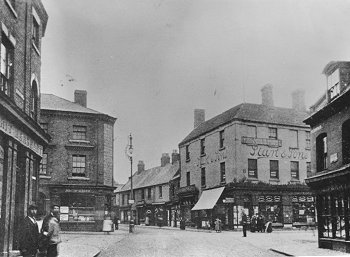
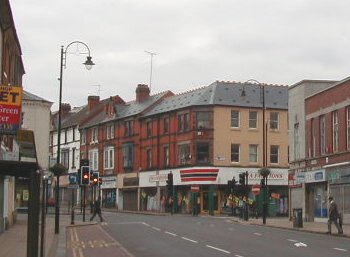 |
This photograph was taken in 1908 at
the junction of Victoria Street, Worcester Street, Cleveland
Street and Salop Street.
It shows the scene shortly before the
two storey shops in the distance were demolished during the
redevelopment of Worcester Street. The fine Georgian house on
the corner of Salop Street was occupied by Start & Sons and was
also the Midland Railway's Parcel Office. The adjacent house on
the corner of Cleveland Street was Garfield's Baker's shop which
advertises bread in the window.
This view from 2000 is quite different. The old Start & Sons
premises has changed considerably and is now dwarfed by the
newer Worcester Street shops. The buildings on the left hand
side of Victoria Street remain, only the shops have changed. The
opposite side tells a different story. The fine old building on
the far corner disappeared when the opposite side of the street
was rebuilt in the late 1920's. |
| This view is of the demolition in
Bell Street just before work started on the Mander Centre. The
building under demolition was occupied by Midland Disposal who
moved to Salop Street.
In the distance is the Odeon cinema and
part of the old School Street Schools. The photograph was
presumably taken on a Saturday due to the large number of parked
cars and the people filling the pavement. Car parking was
obviously as big a problem as ever in the late 1960's. Bell
Street used to extend from Victoria Street through to Snow Hill
until the building of the Wulfrun Centre.
The view today is quite different. The new shops on the right
were built at the same time as the Mander Centre. The scene is
now dominated by the new Beatties extension. |
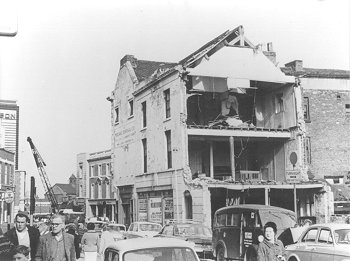
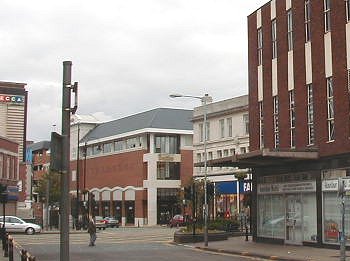 |
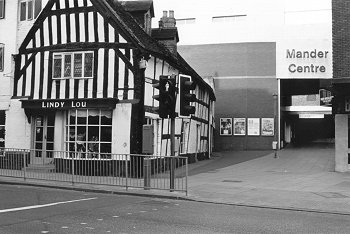
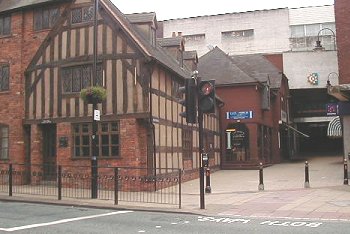 |
This timber framed house known
locally as Lindy Lou's is the town's most famous building after
St Peter's Church. It dates back to the first half of the 16th
century, and in the early 17th century was called the Hand Inn.
The building was situated on the corner of John Street which
disappeared when the Mander Centre was built. Lindy Lou's was a
toy shop, and previously had been a tea shop called The Copper
Kettle, and a bakers.
In the late 1970's Lindy Lou's was
restored. It was stripped down to its timber frame and
completely rebuilt in original style. For a number of years the
building was occupied by the Citizen's Advice Bureau which
eventually moved to Snow Hill. It is now occupied by a second
hand book shop, and collectables shop. The
two shops immediately behind Lindy Lou's were added in the early
1980's. |
| The trolley bus wires are very
prominent in this pre-Mander Centre view. In 1777 the fine brick
house on the far right was occupied by Walter Stubbs who was a
surgeon, and in 1790 it belonged to James Perry.
When this
photograph was taken it housed a branch of George Mason the
grocer's and Yarnolds. On the ground floor of the next building
was Halfords, above which was the Regent Restaurant. The large
store in the centre was occupied by Bedford Williams.
Today's scene is quite different, the whole look of the
street has changed. The buildings on the far left were replaced
by the Mander Centre The modern building in the middle houses
amongst others a pub, which has had a variety of names including
the Newt & Cucumber, the Litten Tree, and currently the
George Wallace. Waterstones book shop is next door. The shops on
the right have all changed hands since 2000, when this
photograph was taken. |
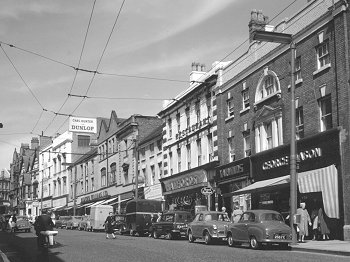
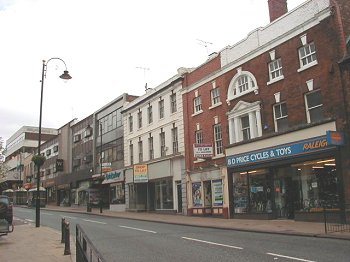 |
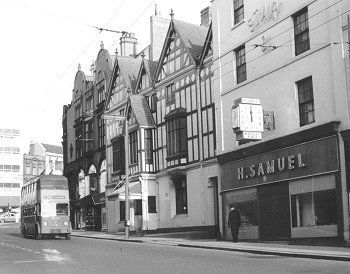
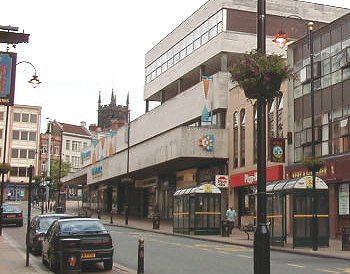 |
The building in the centre is the
Star & Garter which was the town's main hotel. It occupied the
site of a house in which King Charles I sheltered during the
Civil War, and from this the hotel was named.
The hotel was
built in about 1815 and extensively modified in 1836. The
trolley bus on the left is a Roe-bodied Sunbeam which was built
in the late 1940's. These continued in service until March 1967
when the last trolley buses ran here.
All of the old buildings in this part of Victoria Street have
now disappeared. The area was extensively redeveloped when the
Mander Centre was built in the late 1960's.
All that remains to commemorate the Star & Garter Hotel is a
blue plaque. |
| Beatties is the most famous
department store in town. It started life in 1877 as a small
drapers shop in Victoria Street and was called the 'Victoria
Draper Supply Store'.
The store was founded by James Beattie who
started with a capital of just £300 and employed two assistants.
By 1895 he had an annual turnover of £30,000 and had a staff of
forty. The original premises on the eastern side of Victoria
Street was badly damaged by fire in 1896.
This led to the
relocation and expansion of the business on the opposite side of
the street. As the business prospered adjacent premises were
purchased and the store grew in size. The first photograph was
taken before 1929 when the store was rebuilt. James Beattie, the
founder, died in 1934.
The current store had a three million pound facelift in
1989, which included the installation of escalators. In 1992 the
store reached its present size when it was extended into 80
Victoria Street. |
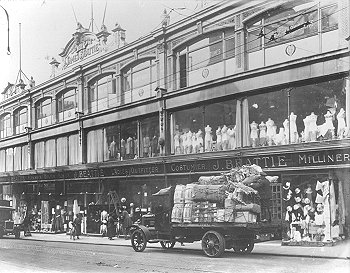
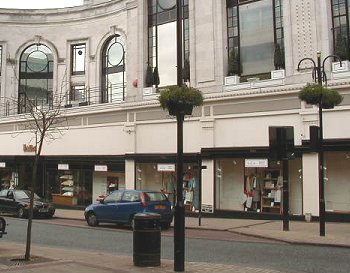 |
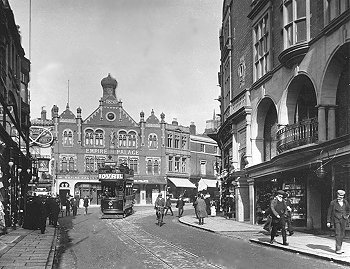
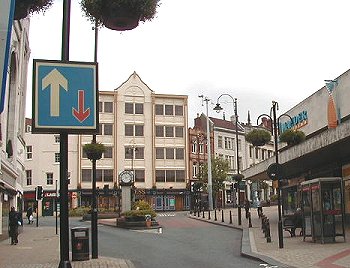 |
On the right is one of the entrances
to the Queen's Arcade, which had a delightful Victorian-style
cast iron and glass roof.
The Empire Palace in the centre was
opened in 1898. It was built on the site of the Cheapside Tavern
which was a pub that included music hall as part of its range of
entertainment. The building was in a Moorish style and was well
known for its music hall and variety shows. It became the
Hippodrome in 1921.
Today's scene is very different. The Queen's Arcade was
demolished to make way for the Mander Centre, and the Hippodrome
was destroyed by fire in 1956. It was replaced by a Times
Furnishing store which in turn was redeveloped into Yates's Wine
Lodge. Beatties now occupies all of the top end of the western
side of Victoria Street.
The clock was built to commemorate Beatties 100th anniversary.
|
| Victoria Street curves down towards
the old Pudding brook which is now culverted, and a boggy area
which was called Boblake. It was originally called Tunwall
Street which means town well street.
Later the name was
changed to Cock Street, after the Cock Inn, and in 1866 when
Queen Victoria visited here, it became Victoria Street. On the
left is A. M. Deans ladies outfitters, and on the right is Beatties department store and Tylers Bootmarket.
None of the original buildings now survive.
The Mander Centre
replaced the buildings on the left, and Beatties rebuilds in
1929 and subsequently, have completely changed the western side
of the street.
|
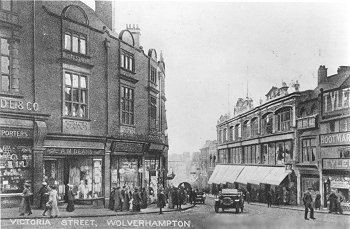
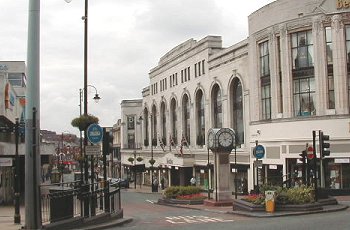 |
 |
|
 |
|
 |
Return to
Queen Square |
|
Return to the
beginning |
|
Proceed to
Dudley Street |
|